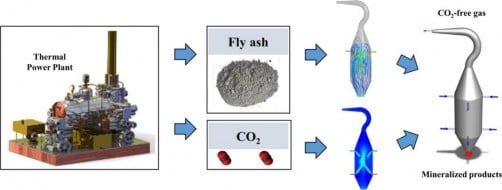As industrialization continues to drive up CO2 emissions, a key contributor to global warming, researchers from Shanghai Jiao Tong University have developed a groundbreaking reactor design that could significantly enhance the efficiency of CO2 capture and mineralization using fly ash, a coal combustion by-product. The study, published in the Energy Storage and Saving journal on May 7, 2024, tackles the challenges faced by existing carbon capture, utilization, and storage (CCUS) technologies, offering a transformative approach to waste management and carbon sequestration.
The research team, led by Dr. Liwei Wang, introduced two reactor designs optimized for CO2 mineralization using fly ash, leveraging computational fluid dynamics to fine-tune their performance. The impinging-type inlet design stood out for its ability to enhance interfacial interactions, prolonging particle dwell times and dramatically increasing mineralization rates. In contrast, the quadrilateral rotary-style inlet excelled in streamlining flow for optimal mixing and reaction efficiency.
Optimizing Operational Parameters for Enhanced Reactor Performance
Through a comprehensive exploration of operational parameters, including flue gas velocity, carrier gas velocity, and particle velocity, the researchers identified optimal ranges that promise to elevate reactor performance, ensuring efficient CO2 mineralization and post-reaction phase separation. These findings mark a significant advancement in CCUS technologies, offering a practical strategy for reducing industrial carbon emissions and aligning with global climate action initiatives.
“Our findings mark a significant leap forward in carbon capture and utilization technologies. By refining reactor designs and operational parameters, we’ve achieved a substantial leap in CO2 mineralization efficiency. This work is not only a boon to sustainable waste management but also presents a pragmatic strategy for curtailing industrial carbon emissions, aligning with global climate action initiatives,” said Dr. Liwei Wang, the study’s principal investigator.
Transforming Waste into a Valuable Resource for Carbon Sequestration
The research holds significant implications for coal-fired power plants, presenting a transformative use for the fly ash they generate. By harnessing this by-product for CO2 mineralization, the study opens the door to reduced carbon emissions and a diminished environmental burden associated with fly ash disposal. The broader applications of this research are far-reaching, offering a harmonious solution to waste management and CO2 sequestration that could revolutionize CCUS technology approaches.
As the world grapples with the pressing need to mitigate climate change, innovative solutions like those presented in this study offer a glimmer of hope. By turning waste into a valuable resource for carbon sequestration, the researchers at Shanghai Jiao Tong University have demonstrated the potential for a more sustainable future, where industrial processes can coexist with environmental stewardship. As the study’s findings are further refined and implemented, they could very well redefine the landscape of CCUS technologies, bringing us one step closer to a low-carbon economy.


